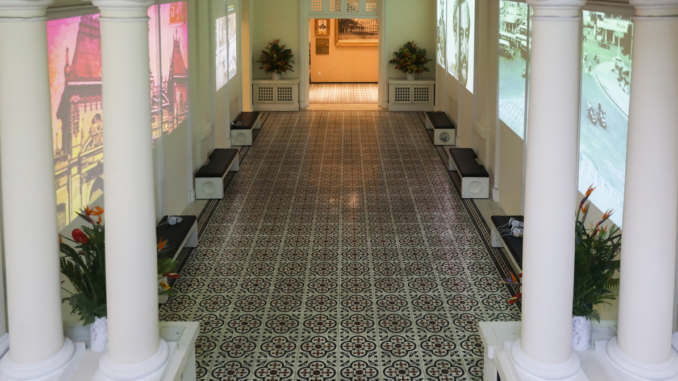
HO CHI MINH CITY – The building is the remnant of the Norodom Palace – a powerful symbol of the French before it was destroyed and replaced by the Independence Palace.

In the campus behind the Reunification Hall (before 1975 was the Independence Palace, in the French period named Norodom) there was an old palace built around the same time as the Palace, in the 19th century.
This building is a secondary work in the Palace campus, currently unknown specific construction time and initial function. Since 1954, when the French withdrew from Vietnam, this place used to be the headquarters of the Democratic Party of the Saigon government. After 1975, the residence was not used regularly.
From 2018 to now, the building is open to visitors through the exhibition of the theme “From Norodom Palace to Independence Palace” , about the formation and development project and historical events of the Palace.

The work was built according to French architecture, with the main door U-shaped, facing Nguyen Du Street, surrounded by a large yard with many ancient soup. The building has two floors, above is a large balcony protruding in a central location.

The building features French architecture with red tile roofs, yellow paint, and many wooden windows. Basic reliefs are decorated at the corners of the walls

Pictures of the Palace from the beginning to the present through historical periods are displayed throughout the corridor.

The building has an area of about 200 m2, still quite intact after more than 100 years of existence. Inside, the typical French-style encaustic cement tile, on the wall, regularly shows pictures of the development of Saigon and Norodom palace.

The first room in the main hall displayed pictures of the Palace when it was newly built.
After occupying six Southern provinces, in 1868, the French government built a residence to serve as the residence for the Governor of Cochinchina in Saigon. The work is called Norodom Palace (the name of a Cambodian monarch).
According to historical data, construction materials were mostly transferred from France. Due to the Franco-German War (1870), until 1873, the project was completed, the decoration part had to be extended for 2 more years.

The doors leading to other thematic galleries have soft lines and harmonious layout.

The wooden staircase leading up to the upper floor is still solid, keeping the ancient look of the building.

On the 2nd floor, there are many documents and images about the new construction process, historic activities and events when this work is completed up to now.
In 1962, the Palace was bombed by the coup, unable to restore the status quo. A new mansion built on the old ground and completed in four years. The new palace like today was built according to the design scheme of architect Ngo Viet Thu – the first Vietnamese to win the Roman Khoi Prize.

The upper floor, which displays documents about the Palace, also has a room that recreates the life of old Saigon, highlighting the enlarged photos of Ben Thanh market.

In front of the building is the Independence Palace, once the residence of the most powerful people, experiencing many historical events.
The palace is 4,500 m2 wide, 26 m high, with an area of 20,000 m2, located in a tree-lined campus. The palace has more than 100 rooms such as the opening ceremony, the cabinet council meeting, the presidential room, the big oats …
On April 30, 1975, the Palace was the place to transfer the power of Saigon government to the Revolutionary government, ending the war, unifying the country. In 1976 the work was recognized as a special national monument.
Currently, the Independence Palace is a famous historical relic, attracting many tourists. The ticket price for adults is 65,000 VND per person, including visiting the display “From Norodom Palace to Independence Palace”. Follow Vnexpress
